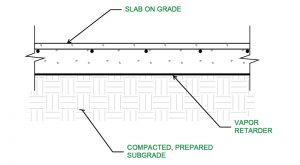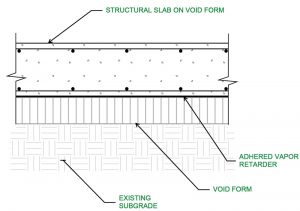Structural Slab on Void Forms vs. Conventional, Soil-Supported Slab on Grade
In expansive soil regions, the Geotechnical Engineer for a project usually provides recommendations for grade-level floor construction – structural slab on void forms or conventional slab on grade – based on the existing subgrade properties, excavation depth, and compaction of select fill. The Structural Engineer of Record (SER) then provides a comparative study of both options. Conventional slab on grade is generally a thinner, lightly reinforced slab requiring excavation and replacement of subgrade with a select fill but is subjected to movements as the existing subgrade heaves. In contrast, the structural slab on void form option often requires a thicker, heavily reinforced slab spanning between larger column foundations and other intermediate foundations but without undercutting or removing the existing soil. The void forms allow for placement of wet weight of concrete during construction but absorb ground moisture gradually and lose strength after the concrete has set, thus creating a gap under the slab to allow for soil movements. The final decision by the owners is usually based on the comparison of the initial construction cost of each option without fully understanding the short- and long-term consequences.

This article attempts to take a holistic approach to this comparison between a conventional slab on grade and a structural slab on void form to help the SER educate owners, architects, contractors, and other disciplines to enable them to make an informed decision. Additional considerations beyond construction costs are outlined below and should be discussed with all stakeholders in the project:

- Potential Vertical Rise (PVR): A baseline for PVR, a measure of the swell potential of the soil, needs to be established for the project based on the current and future building occupancy in consultation with the owners. This is important in determining the depth of excavation of the existing subgrade and replacement with select fill and determining the duration of compaction of subgrade under the conventional slab on grade. In addition, a baseline PVR could play a role in the choice of a flooring less sensitive to movements on slab on grade, relocating equipment sensitive to movements away from slab on grade, or choosing a structural slab on void form option for a portion or all the grade level floor construction.
- Differential movement: Expansive soil-related movements are essentially eliminated when using a structural slab on void form if a sufficient gap is maintained under the first floor, but, in a conventional slab on grade, differential movement is possible and should be expected. The owners should be educated about the cracks that are likely to occur in a floor slab and potential distress to floor-supported finishes and interior walls due to the differential movement in slab on grade despite mitigating efforts such as thickening the slab under the interior walls.
- Landscaping: The presence of trees and vegetation adjacent to the building exacerbates the formation of cracks in slab on grade due to moisture loss in the subgrade from transpiration to the root systems of the vegetation. On the other hand, large trees with extensive root systems do not pose a significant risk to a project with a structural slab on the void form. Landscaping around and adjacent to the structure, existing or future, should be carefully selected to prevent roots from migrating beneath the structure and changing the soil moisture content.
- Crawl Space: If a crawl space is introduced under the structural slab at the grade-level floor, owners should be advised that proper ventilation, perimeter closure, lighting, and crawl space access need to be provided and maintained throughout the life of the building to reduce moisture accumulation and humidity within the crawl space.
- Early Coordination: Slab on grade construction is more forgiving towards accommodation of trenches, slab depressions, or openings coordinated after the foundation placement, provided that they do not conflict with column foundations. Conversely, slab openings significantly affect the punching shear capacity of a structural slab on void form. Therefore, the trenches and depressions in the slab need to be coordinated around additional intermediate piers. The importance of accelerated coordination at the grade level floor should be emphasized to all the disciplines, the contractors, and the owners.
- Future modifications: Owners should be made aware of the limitations of future modifications to the grade level floor, if any, with each type of construction. The slab on grade construction tends to provide flexibility to the owners when it comes to adding openings or trenches in the future. At the same time, structural slabs on void forms require closer attention to detailing and identification of permissible areas where future openings could be added.
- Under-slab utilities: In the case of structural slab on void forms, the under-slab utilities are hung from the structural slab. A sufficient gap is maintained underneath so that the utilities are not affected by the movements in the expansive soils. The utilities typically have an expansion joint at the building perimeter to account for the differential movement between the building slab and the surroundings. In the case of slab on grade, if not protected correctly, the utility trench serves as a conduit that permits moisture migration under the slab. The utility trenches are typically backfilled with properly compacted clay fill and capped with a bentonite clay plug at the building perimeter to restrict moisture from migrating under the slab. The owners should be educated on the proper placement and maintenance of each option’s existing and future utility trenches.
- Flood Zone: In high or frequent flood zones, where the scouring of the top layer of soil is expected, a structural slab can provide a viable and, in some cases, the only alternative. The cost of additional foundations or a thicker structural slab on void forms should be weighed against the cost of flood mitigation options, such as flood walls, otherwise required around the building with a conventional soil-supported slab on grade.
In conclusion, by discussing the advantages and disadvantages of a conventional slab on grade and a structural slab on void form, the SER can help all stakeholders understand the risks associated with each option and prepare a risk mitigation plan critical for the success of long-term durability and performance of the building.■
